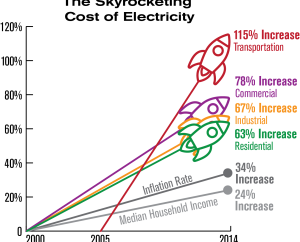The Energy rates can be isolated into plant-level expenses, lattice level expenses, and different expenses. Power to Choose energy costs to comprise capital, activity and support and fuel cost. Capital expense is reflected in the expense of age via interest on obligation and return on value. For thermal energy stations, the capital expense is high, yet the fuel cost is low. For coal-terminated force plants, capital expenditure is low, yet fuel cost is high. The capital expense of sun-powered and wind is constantly diminishing; fuel cost is nil.

Power arrives at a customer through the network. Laying a network needs critical ventures. A wholesaler purchases power from a generator, adds transmission and conveyance charges, a charge to recuperate specialized misfortunes, working costs, and his benefit to decide the tax to be charged from a customer. Since a few generators are associated with the network, collaboration with the matrix and lattice the board strategies impact the working of a generator. As of now, power markets don’t relegate any cost to framework impacts, that is, to the mind-boggling collaborations among different generators associated with the matrix.
Framework level expenses have a few segments:
- network association, lattice augmentation and support, momentary adjusting costs, and long haul costs for keeping up the satisfactory backup supply. VRE sources request a lot higher backup, matrix association and support costs. This angle needs consideration during strategy formulation.
- The accentuation on VRE sources with no interest in energy stockpiling has changed over the day by day load profile for dispatchable producing stations into a “duck bend”, that is, with a diminished power load during the day when sunlight based is free and a fast increase in the evening.
- This brings down the limit factor of dispatchable generators. The DNEP recognizes mechanical and operational difficulties presented by the mix of VRE into the matrix. It features the deficiency of age proficiency, high support cost, and higher emanations of consolidated cycle plants because of cycling and inclining.
Other energy rates :
- Different expenses incorporate those emerging from the impact of power age on wellbeing, effect on existing age limit due to adding new limit, cost of mishaps, security of provisions and net energy acquired for society. In the Economic Survey 2016-17, an endeavour has been made to assess network-level expenses and some different expenses.
- The overview utilizes the term ‘social expense of carbon’ to address the monetary expense of ozone-depleting substance discharges. It likewise adds wellbeing costs, expenses of irregularity, the opportunity cost of land, cost of government motivations and cost emerging from abandoned resources.
- It, in this manner, incorporates framework cost, however a huge piece of different expenses also. It gauges that the absolute social expense of renewables was ₹11 per kWh, around multiple times that of coal. Customary measurements like Levelized cost of power age can’t be depended on to think about discontinuous and dispatchable electric stockpile choices.
- India’s power necessities are colossal. It’s anything but an ‘innovation versus innovation’ banter, however, an approach structure that coordinates all low-carbon energy advancements with coal in a way that guarantees dependability and security of electric inventory alongside reasonableness and environment strong turn of events.
